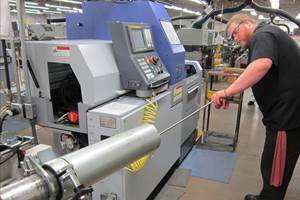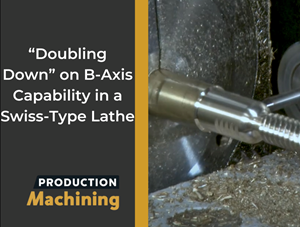Brother and sister Jacob Knuepfer and Amy Primrose represent the next generation of leadership at Denver Precision Products as their father and current company owner, Claude F. Knuepfer, will soon pass the torch to them. Source (all photos): PM
Denver Precision Products is a contract CNC machine shop that finds itself in a period of transition in a couple ways.
Firstly, siblings Jacob Knuepfer and Amy Primrose are preparing to take the reins from their father and the company’s current owner, Claude F. Knuepfer. Succession planning for this family business started passively a decade ago and in earnest five years ago with Jacob and Amy now meeting biweekly with a succession plan advisor.
Secondly, the shop is adopting more advanced machining equipment especially when it comes to Swiss-type lathes. This perhaps doesn’t rise to the level of the sea change that occurred in the 1980’s when the company made the move away from cam-actuated screw machines to CNC machines. But new Swiss-types with technology such as oscillation cutting, pinch turning (and milling and knurling) and B-axis rotation are setting the shop up to further pursue the type of complex work at which it excels.
Transitional Tales
The Knuepfer family’s manufacturing heritage dates back more than a century. Here’s how Denver Precision Products explains its family’s manufacturing history:
“In 1922, Claude A. Knuepfer began his journey in the world of manufacturing. After World War II, his two sons, Jack Knuepfer and Bob Knuepfer, continued the legacy in manufacturing by settling into the world of turning (cam-operated screw machines at the time). Both sons grew their businesses. Today, there are shops that span multiple states and service many different industries. Denver Precision Products was originally opened by Jack Knuepfer, but soon after, the torch was passed to the next generation, Claude F. Knuepfer.”
The shop’s Tsugami SS327-III-5AX features a servo-driven B axis to mill, drill and tap parts at various angles.
Today, the 12-person shop focuses on manufacturing parts ranging in diameter from 0.03 to 1.625 inches in quantities of 100 to 100,000. Approximately 90% of its work is from repeat customers. It has produced parts for the hydraulic, computer, aerospace, medical, military, electrical, secondary automotive, industrial painting, oil exploration, injection molding and other industries. The shop’s volume of sales has increased over the years, too. It shipped approximately 700,000 parts in 2016, but that grew to 2.5 million in 2022.
Denver Precision Products has centerless grinding and milling capabilities. It also has finishing equipment including magnetic deburring, vibratory tumbling and centrifugal high-energy finishing, and performs some assembly work for customers that request it. That said, it is first and foremost a precision CNC turning company with capabilities that are said to be rare in its neck of the woods.
The concept of pinch turning can be applied to knurling, too. Here, a diagonal left and right knurl are used to create the signature diamond-pattern.
The shop has settled on Miyano fixed-headstock production turning centers (offered by Marubeni Citizen-Cincom) as well as Tsugami Swiss-type lathes. All machines feature a sub spindle and live tooling. In addition, 12-foot bar feeders are preferred as that is the length of stock the shop purchases and it enables longer stretches of unattended operation.
One of the new Tsugami Swiss-types, a SS327-III-5AX, has a B axis to enable milling, drilling and tapping at various angles. When using the B-axis milling spindle, this lathe essentially becomes a five-axis turn-mill with the bonus of a sliding headstock. The sliding headstock is what enables the machine to effectively turn long parts with small diameters, while the B-axis milling spindle can approach workpieces in the machine’s main or subspindle at a variety of angles. This makes it possible to eliminate secondary operations by machining parts complete.
Pinch knurling ensures equal pressure is applied to both sides of a part. This is helpful to produce the knurl for long part such as this one without a special tool that would need to provide extra support to counteract tool pressure.
The B-axis machine is relatively new, and the shop is still in the early stages of taking advantage of that capability. But it is a good example of future proofing to be able to perhaps more effectively accommodate the types of complex parts on which the shop focuses. It is one example of how Denver Precision Products is advancing in terms of Swiss-type technology.
Another is pinch machining, a process the shop applies in three ways. Pinch turning is commonly performed to machine workpieces having high length-to-diameter ratios such as those often produced on Swiss-types. This minimizes part deflection due to tool pressure, because the radial forces of the opposing turning tools counteract each other. Pinch turning on the Swiss-types enables the shop to take much larger depths of cut and achieve better roundness having two single-point tools in the cut simultaneously.
During pinch turning, one tool leads the other typically by 0.01 to 0.02 inch. In some cases, the depths of cut are the same on either side. However, for improved surface finishes, as much as 90% of the cutting is performed on the leading tool meaning the second tool performs only a light pass to achieve a quality finish. In one example, better than a 15 Ra finish is achieved on a part machined from 1144 steel which is subsequently nickel plated. If not for that, grinding would be required prior to plating.
Approximately 40% of the work that runs across the shop’s Swiss-types are performed in chucker mode with the guide bushing unit removed as shown here.
Pinch milling offers the ability to take cylindrical material down to a square cross section. During conventional machining, a single end mill is used. However, by the second, third or possibly fourth flat, there is not much material remaining on the opposite side to offer support against tool pressure. During pinch milling, two identical end mills pinch the material to support it between themselves in the same manner as pinch turning. For this, one tool does not lead the other.
Plus, the shop has found that pinch machining can be applied to knurling, too. In this case, diagonal left and right knurling tools are used to create the signature diamond pattern. Because equal pressure is applied to both sides of a part, it is possible to knurl long parts without a special tool to provide adequate support to counteract tool pressure. The key is to ensure the touch-off point for each tool is the same such that one is not applying more pressure on the workpiece than the other.
Getting Chippy
Denver Precision Products machines a range of materials including alloy steel, stainless steel, titanium, copper and plastics such as Delrin. The last two are examples of gummy materials that can produce long, stringy chips during turning. Therein lies the value of what Tsugami calls oscillation cutting, which can to help break chips in malleable materials.
According to the machine tool builder, this process oscillates a servo axis and cutting is performed by synchronizing the oscillation of that axis with the rotation of the main spindle. Interruption in the cut breaks material into small chips. In addition to eliminating a chip buildup problem, the interrupted cut is said to reduce the amount of heat concentrated at the cutting area.
Plastics are a good candidate for oscillation cutting. Long, stringy chips are commonly created when turning these materials via traditional methods unlike these which were produced using the oscillation cutting function.
The oscillation in and out of the cut happens so rapidly it is impossible to see with the naked eye. According to Tsugami, a typical oscillation rate is 1.5 cycles per 360 degrees of spindle rotation which creates a harmonic frequency less than 50 Hz.
Oscillation cutting is performed by specifying the dedicated G code (G8.5P2). It is valid until canceled with G8.5P0. Oscillation data is calculated based on the main spindle speed and the feed rate of the specified axis, and oscillations per revolution and depth of oscillations are specified within the program. The oscillation cutting function is strictly driven by software. No extra hardware is needed.
Oscillation cutting can be used for turning, drilling, boring, grooving and cutoff operations. In fact, Denver Precision Products’ newest Swiss-type offers oscillation cutting on both the main and subspindles. The shop sometimes performs oscillation cutting and pinch machining simultaneously. That’s because with pinch machining, there are two tools in the cut creating chips very close to each other. Oscillation cutting helps keep those tools free from stringy chips.
The shop continues to invest in advanced inspection equipment such as this Oasis Elite optical inspection system. This system offers near instant part measurements accurate to ±0.0001 inch.
What’s on the Horizon?
As with many high-volume machine shops, part inspection can become a bottleneck. That’s why Denver Precision Products has added equipment including an Oasis Elite vision system and OGP C-Vision optical comparator with edge detection and video measurement capabilities. With respect to inspection, the next step might be to automate these processes with a robot (or cobot).
This might or might not happen. But it is yet another example of how this shop is continuously searching for ways to become more efficient and effective. (Claude says he finds IMTS to be very valuable for discovering new technology, and has gone to many events over the past few decades.) Denver Precision Products is on my list of shops with which to follow up in the coming years. That’s because my visit last October represented a snapshot in time. The company will have advanced even further when I next visit.
Related Content
Pursuit of Parts Collector Spearheads New Enterprise
While searching for a small parts accumulator for Swiss-type lathes, this machine shop CEO not only found what he was looking for but also discovered how to become a distributor for the unique product.
Read More6 Tips for Training on a Swiss-Type Lathe
There are nuances to training a person to effectively operate a Swiss-type lathe. A shop I visited a while back offers some suggestions.
Read MoreSoftware Controls Chip Breaking in Thread Turning Operations
This cutting tool manufacturer has developed a software module for chip control of thread turning operations in virtually any CNC lathe, even for older machines, using specific tooling and software.
Read MoreVideo Tech Brief: “Doubling Down” on B-Axis Capability in a Swiss-Type
This Swiss-type lathe has two programmable B-axis units and the capacity for two individual thread whirling units.
Read MoreRead Next
5 Aspects of PMTS I Appreciate
The three-day edition of the 2025 Precision Machining Technology Show kicks off at the start of April. I’ll be there, and here are some reasons why.
Read MoreA Tooling Workshop Worth a Visit
Marubeni Citizen-Cincom’s tooling and accessory workshop offers a chance to learn more about ancillary devices that can boost machining efficiency and capability.
Read MoreDo You Have Single Points of Failure?
Plans need to be in place before a catastrophic event occurs.
Read More

















.jpg;maxWidth=300;quality=90)

.jpg;maxWidth=300;quality=90)










